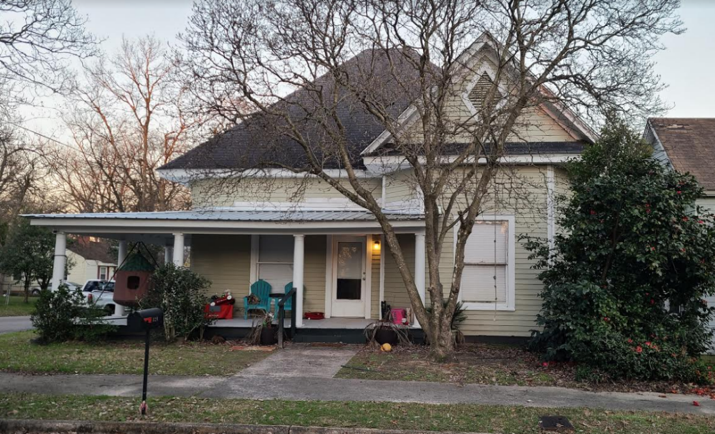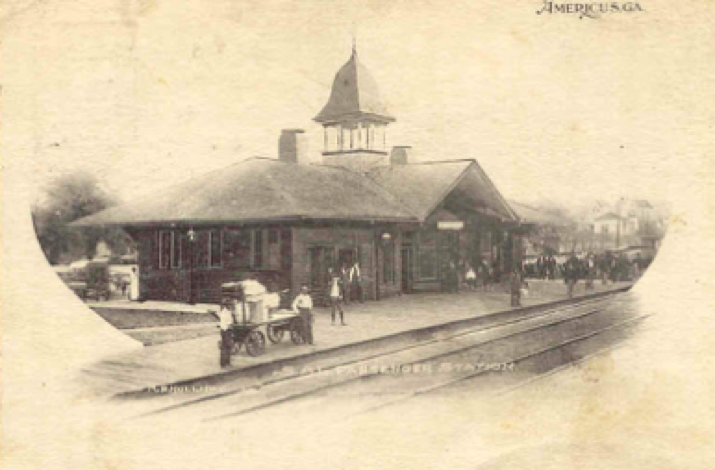Influenza in Americus
Published 8:17 am Wednesday, April 27, 2022
|
Getting your Trinity Audio player ready...
|
Part 1: The Force of a Train
By: Evan Kutzler
John Bradshaw knew the dangers of being a railroad foreman and, later, the superintendent of bridges and buildings on the Seaboard Air Line Railway. It did not save him. He first felt ill aboard an incoming train on Saturday, October 5, 1918. From the Jackson Street Depot, the most direct path home would have taken Bradshaw east on Finn Street and Brannan Avenue to his wife and daughter at 420 Barlow Street. “He reached home,” the Americus Times-Recorder reported, “and shortly after summoned a physician, his illness growing steadily worse until death relieved his sufferings.” The Americus Undertaking Company, on the first floor of the Allison Building, prepared his body for transportation. At noon on Monday, October 7, an outgoing train took his body for burial to North Carolina. The death hinted at what was to come.
No official death record exists for Bradshaw and the Times-Recorder did not call it influenza. This is not surprising. Until the first week of October, the local newspaper paid little attention to the pandemic. “It is nothing more nor less than ‘la grippe,’ as the French call it,” the paper stated, “or plain, old-fashioned ‘grip,’ as we are used to hearing it named.” While the Times-Recorder admitted the influenza was spreading on military bases, writers downplayed the risk to civilian populations.
Officers at Souther Field, a new air base built during World War I, took the first local steps to slow the spread of the disease. Souther Field represented the newest branch of the U.S. military. Beginning in late spring of 1918, 25 new cadets in the air corps reported there each week until the fall. In early October, officers attempted to shield cadets from the disease by limiting their exposure to the local population. “Until further notice,” the post announced one day before Bradshaw fell ill, “none of the soldiers or officers at Souther Field will be permitted to go to any places of public assembly, such as picture shows, theatres, dances, etc.” Late the next day, authorities clarified that the order did not restrict airmen from attending church. The clarification appeared the same Sunday morning Bradshaw died
Multiple factors motivated newspapers to downplay influenza. A new Sedition Act during World War I criminalized criticism of the U.S. government. Newspapers faced political and legal pressure to avoid printing information that could damage morale in the military or the country’s war efforts. For months in the fall of 1918 and the winter of 1919, many newspapers in the United States reported that the disease was under control as if repeating it again and again would make it so.
The severity of influenza may also have motivated local, state, and national newspapers to double-down on euphemism. The same newspapers depicted murders, car accidents, and self-inflicted deaths in graphic detail often softened influenza. The description of Bradshaw’s rapid decline may not have immediately registered to readers as influenza, but it fits a pattern of cases elsewhere in the country. Many patients died of secondary infections after weeks of illness. Other victims, like Bradshaw, succumbed to the strange disease in a matter of hours.
This disease, as historian John Barry describes in The Great Influenza, traumatized victims and survivors, including doctors, nurses, and caregivers. From Camp Devens in Boston, Massachusetts, Dr. Roy Grist described how quickly some patients died. It could take only a couple hours for a patient who entered his hospital with mild symptoms to begin showing blue spots on the face from ear to ear. This was called cyanosis and it meant the patient’s lungs were not properly transferring oxygen to the blood. For Grist, the blue spots signaled that it was “only a matter of a few hours until death comes.” In addition to sweating and chills, influenza victims also suffered nose bleeds and delirium. These were not “heroic” military deaths and influenza was not the military sacrifice the U.S. government asked the nation to shoulder. Perhaps it is no wonder that the real disease rarely made it into the paper.
Whether or not Bradshaw was the link that brought influenza to Americus, influenza cases must have arrived in the city on the rails. The same transportation routes that underlay the regional economy and brought people like Bradshaw to Americus also made the vibrant city vulnerable to communicable diseases. Edward Paschal Markette, a 37-year-old engineer on the Seaboard Air Line Railway, fell ill days after Bradshaw. He died from pneumonia about a week later at his parents’ home at 1001 South Lee Street. Twenty-five-year-old Marion Reeves, a conductor on the Seaboard Air Line, died two weeks later after an unnamed “brief illness.” His surviving family lived on Furlow and then on Barlow street in Americus for many years to come.
While the infection could easily spread outdoors, crowded railcars—like military barracks—made passengers easy targets for small droplets in the air that carried the virus. On September 25, 1918, officials at Camp Grant in Rockford, Illinois, transferred 3,100 soldiers to Camp Hancock near Augusta, Georgia. Camp Grant was in its fourth day of a surge in cases and many soldiers were already infected when their train left for Georgia. Aches, fevers, sweats, nosebleeds, and delirium appeared among the travelers. Approximately 25% of the passengers on that train went straight to the hospital and 10% died from influenza or secondary pneumonia.
By the time Bradshaw fell ill, it was no more possible to stop what was coming than it was to stop the spread aboard that train from Rockford to Augusta. The inoculation time for influenza is one to four days, and during that time after Bradshaw’s death the newspaper continued to publish only its optimistic outlook. Mild weather in the South, one article asserted, would keep the death rate low. During those same days, the city government announced that it would enforce the city ordinance against spitting on the sidewalk. “The enforcement of this ordinance is part of the program adopted to prevent the introduction of ‘Spanish flu,’ in Americus,” the Times-Recorder announced, “and Chief Olin Johnson says cases will be made against all citizens who fail to observe the law in future.”
It was too little, too late. That same day, doctors acknowledged that influenza was in Americus. “There are about fifty cares here,” a group of doctors told the newspaper, “but none of the patients are in a serious condition and there is small fear that an epidemic will occur.” City Physician Dr. Douglas B. Mayes, who died four months later of complications from influenza, announced that homes with influenza would be quarantined and the children from those homes were prohibited from attending school. Lieut. D. W. Tiedman, United States Public Health Officer, sent letters to local merchants ordering “clerks who sneeze during working hours to be restrained from selling food to the public.” Officials at Souther Field began limiting indoor crowds.
***
Influenza may or may not have been in Americus when Bradshaw returned to the Jackson Street depot. At some moment in early fall, though, there was an unseen turning point. The exact chronology—first, the tenth, the hundredth case—cannot be reconstructed. What came next mattered more anyway. Four days after Bradshaw returned home, there were 72 cases. After 12 days, there were 354 cases. As the presence of the disease became undeniable, its effects became unavoidable. A local history of medicine in Sumter County estimates that 1200 people fell ill at one time, including most of the physicians, and about 25% of the cadets at Souther Field. The pandemic, which elsewhere had already picked up the grim moniker of “plague,” hit the region with the force of a train.
This is the first installment of a short series on the 1918-20 influenza epidemic in Americus. As the seriousness of the Covid-19 pandemic became clear in the spring of 2020, I started researching the city’s experience during this earlier pandemic. Restricted access to public spaces meant casting a wide net for sources. Newspaper accounts, death records, family tradition, and the scores of cemeteries became an unofficial “archive” for this public history project. Along the way, I wrote “Dear Santa in a Year of War and Pestilence” for the Times-Recorder and taught two research classes at Georgia Southwestern State University on the influenza pandemic. After urging my students to think about public-facing public history products, we built Influenza in Americus (https://www.influenzainamericus.com/) and a small physical exhibit in the GSW library. This series will highlight some of the stories and themes from this ongoing project.
Part 2 of this series will appear next week. Feel free to contact me at evan.kutzler@gsw.edu with any information that may shed light on the local experience of influenza in Americus.




